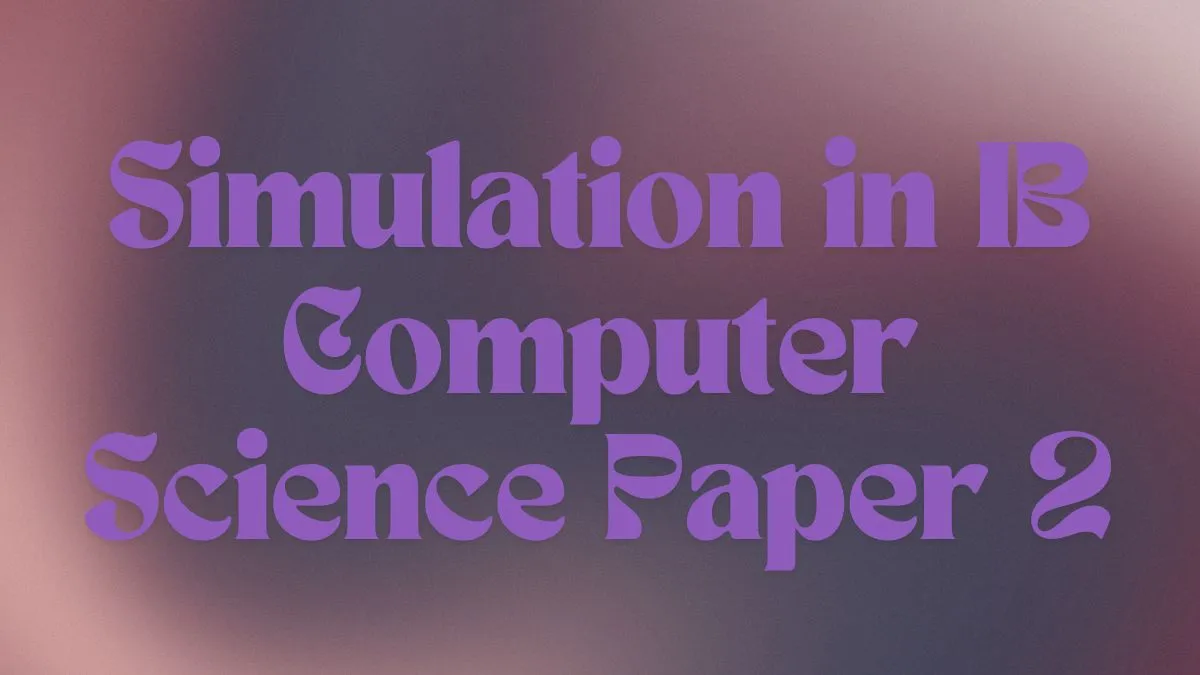Introduction of Simulation in IB Computer Science Paper 2
The use of simulations is essential for the evaluation of comprehension of different computational ideas in the context of the second IB Computer Science Paper. In this analysis, we take a look at the importance, methods, and consequences of employing simulations in the examination process as a whole.
Understanding Simulations in IB Computer Science Paper 2
The use of simulations, which provide a hands-on means of evaluating theoretical understanding, is central to the IB Computer Science curriculum. One key feature of simulations is their capacity to mimic real-life situations using theoretical models. Student understanding of complicated algorithms and data structures can be demonstrated in a regulated setting through the use of simulations. For students to better understand and implement theoretical principles when faced with real-world challenges, this kind of practical training is essential.
The Role of Simulations in Exam Preparation
Paper 2 students can benefit greatly from using simulations to learn and practise problem-solving strategies. In the first place, they make it possible to put theoretical knowledge to use in real-world contexts. The second benefit of simulations is that they provide a real-time environment in which students can test out various techniques. Computational complexity, data structures, sorting algorithms, and other fundamental ideas can be better grasped with the aid of this interactive method.
Methodologies for Implementing Simulation in IB Computer Science Paper 2
There are a variety of approaches that can be used to successfully include simulations into the IB Computer Science curriculum. Making simulation models in computer languages like Python, Java, or C++ is one typical method. The building of precise and comprehensive simulations is made easier by the many features offered by these languages. If you need to build a simulation incorporating complicated algorithms, Python is a great option because to its abundance of libraries and its relative ease of use.
The employment of dedicated simulation programmes is another approach. You can tailor these tools to meet your individual simulation needs by utilising their pre-built modules and features. Students can avoid becoming mired down in the nitty-gritty of programming and instead concentrate on the big picture when they use this software to run simulations.
Key Aspects of Effective Simulations
The success of the simulations in Paper 2 depends on taking a number of important factors into account. First and foremost, the simulation model must be accurate. It is important to take into account the underlying assumptions and constraints so that the model appropriately represents the simulated problem. This precision guarantees that the simulation’s output is accurate and trustworthy.
Second, how well the simulation works is really important. The simulation needs to have an easy-to-understand interface that lets users change the parameters and variables with a breeze. Both the learner running the simulation and the examiner looking over the findings will benefit from its usefulness.
The Impact of Simulations on Problem-Solving Skills
The ability to solve problems is greatly improved by using simulations, which offer a dynamic setting for testing and analysis. Students can test out several approaches to an issue and evaluate how well they work through simulations. An improved grasp of algorithmic ideas can be achieved through this repetitive approach, which also promotes critical thinking.
Plus, with the help of simulations, kids can see intricate algorithms and processes. This visual representation helps to understand complex ideas and allows for a more natural comprehension of the interplay between various parts of a system.
Challenges and Considerations
There are still some problems with simulations that need fixing, despite all their benefits. Assuring that the simulation faithfully mimics the target real-world situation is one obstacle. The credibility of the results and the value of the learning experience are both compromised by inaccurate simulations. Consequently, it is crucial to test and compare simulation models with real-world data in order to validate them.
A further factor to think about is the amount of computing power needed to run the simulations. Some pupils may not be able to handle the processing power and memory requirements of more complex simulations. Consequently, you should not overextend yourself in the simulation if you do not have enough resources.
The Future of Simulations in IB Computer Science
The future of simulations in IB Computer Science is likely to change in tandem with technological developments. The future of simulations may be shaped by new technologies like machine learning and artificial intelligence. New opportunities for developing more complex and realistic simulation models have opened up because to these technologies.
In addition, distributed systems and cloud computing can be integrated to make simulations more accessible and scalable. The use of simulations in computer science teaching will grow in importance as technology progresses.
Conclusion
Finally, the second IB Computer Science Paper relies heavily on simulations, which provide a hands-on, interactive means of learning and practicing computational principles. Students can make good use of simulations to learn more about computer science and improve their problem-solving abilities by using different approaches and paying attention to important details. New possibilities for research and education in computer science will arise as a result of the ever-changing function of simulations brought about by technological advancements.

